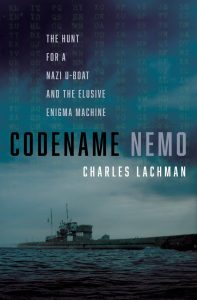Code Name Nemo was the name eventually given to one of the most daring and audacious missions of World War II – the effort to capture a German submarine intact. Charles Lachman joins us to share this fascinating and still little known story. The capture of U-505 was the first time since the War of 1812 that an enemy vessel was boarded and captured.
Lachman is the Executive Producer of the nationally syndicated news program “Inside Edition” and the author of four books. In Code Name Nemo, Lachman uses archival documents and taped interviews with actual crewmembers to give the reader a deep familiarity with the sailors involved in this mission.
They include the maverick Navy Captain Daniel Galley, who first dreamed up the plan as well as one of the ill-fated German U-Boat Commander who committed suicide on board during a depth charge attack. Lt. Albert David led the boarding party and would eventually be awarded the Medal of Honor. Also key to the mission was ship’s mechanic Earl Trosino and Ewald Felix, a defecting German crew member who helped keep the U-505 stabilized and afloat so that it could be towed to an allied port.
Critical to Galley’s plan was for his antisubmarine task force to do sufficient damage to the enemy submarine to get her to surface and force the crew to abandon ship without destroying the vessel. Between engaging in a shootout with any German sailors remaining on board the sub sinking from any demolition charges left behind, the brave sailors who comprised the boarding crew knew they were likely on a suicide mission.
The capture of U-505 was an intelligence coup. However, the captured crew would have to be segregated and the submarine disguised so the Nazi’s would never realize it was captured. Renaming the ship “Nemo” in all communications was a key part of this strategy.
We also discuss the sometimes difficult decisions that have to be made in war, including the many violations of the Geneva Conventions that resulted from this secret plan.
The U-505 is on display at the at the Griffin Museum of Science and History in Chicago.

